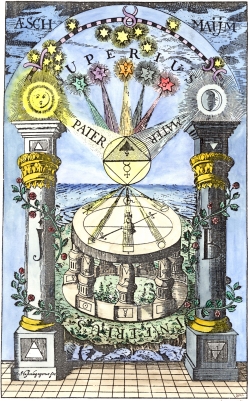So I think the best place to start is with Alchemy itself, what is it, what is the expected result, when does the gold rain down, and is there an app for that?

What exactly is alchemy?
We have all been presented with the rather romanticised view of the venerable old alchemical philosopher huddling over his flasks of bubbling liquid immersed in his quest for the elusive philosophers' stone, a mere grain of which will change a mass of molten lead into the purest form of gold.
This image of the alchemist was one which developed relatively early on in the history of alchemy, but it became a very popular view in the 20th century and to most people this is almost all they know about the subject.
Another view that developed was that alchemists were mysterious adepts belonging to some secret society and exchanging messages in a coded form. They were even seen as having paranormal powers which enabled them to do all sorts of magical things and live to an extreme old age. Thus alchemists became confused in the popular imagination with the image of the magician.
These stereotypical views of alchemy do not really allow us to appreciate the breadth of alchemy and the various ways in which it inspired people over the centuries. This introductory section will, hopefully, let us gain a broader picture of this amazing subject.
We have all been presented with the rather romanticised view of the venerable old alchemical philosopher huddling over his flasks of bubbling liquid immersed in his quest for the elusive philosophers' stone, a mere grain of which will change a mass of molten lead into the purest form of gold.
This image of the alchemist was one which developed relatively early on in the history of alchemy, but it became a very popular view in the 20th century and to most people this is almost all they know about the subject.
Another view that developed was that alchemists were mysterious adepts belonging to some secret society and exchanging messages in a coded form. They were even seen as having paranormal powers which enabled them to do all sorts of magical things and live to an extreme old age. Thus alchemists became confused in the popular imagination with the image of the magician.
These stereotypical views of alchemy do not really allow us to appreciate the breadth of alchemy and the various ways in which it inspired people over the centuries. This introductory section will, hopefully, let us gain a broader picture of this amazing subject.
So how should we view alchemy?
Alchemy is a multifaceted subject. It is an early form of chemical technology exploring the nature of substances. It is also a philosophy of the cosmos and of mankind's place in the scheme of things. Alchemy developed an amazing language of emblematic symbolism which it used to explore the world. It had a strong philosophical basis, and many alchemists incorporated religious metaphor and spiritual matters into their alchemical ideas.
About four thousand printed books were issued from the 16th through to the late 18th centuries, exploring alchemy from a multiplicity of different perspectives. Many thousands of manuscripts, hand written works, letters, notes and commentaries exist in the libraries of Europe and North America, some beautifully illustrated with coloured images. Alchemy was thus, through the sheer volume of writings, influential throughout the early modern period. Its influence can often be seen in the work of writers, poets, and artists of the time.
In the 20th century, interest in alchemy was revived, following its decline and total eclipse in the 19th century. Today alchemy is often used as a catch word for obscure and enigmatic symbolism, or for the idea of spiritual transformation and inner change.
How is alchemy approached today?
Gold in alchemy
The attainment of rubedo, or redness, is symbolized by the transmutation into gold. The alchemists often talk about ‘living gold’. The ‘living gold of the philosophers’ is the pure fire that is in the philosopher’s stone, or in quicksilver, or in the root humidity of nature which is completely penetrated by the fire. The living gold is the fixated seed that vivifies the philosopher’s quicksilver and the matter of the stone, that is the root humidity of metals. It is a light that is clothed by a perfect, pure ethereal body. It all sounds mystifying, but read it again and know that the living gold is actually pure consciousness, or pure awareness.
Alchemy the App
(this is purely my attempt at humor )
(this is purely my attempt at humor )
Next Week :
THE THEORY OF ALCHEMY
by Paracelsus

No comments:
Post a Comment